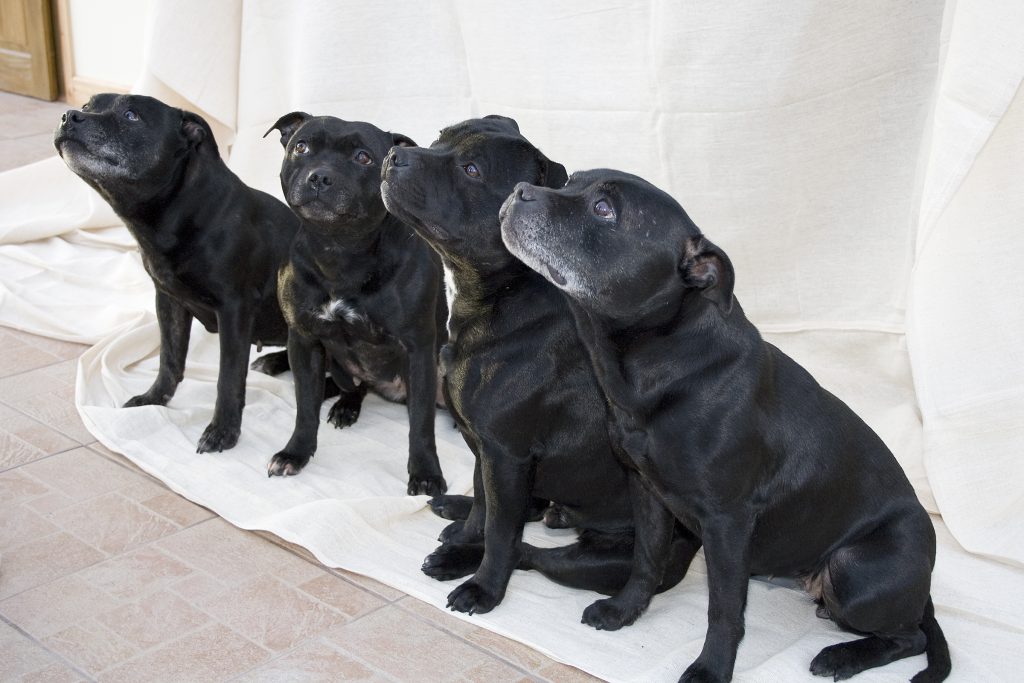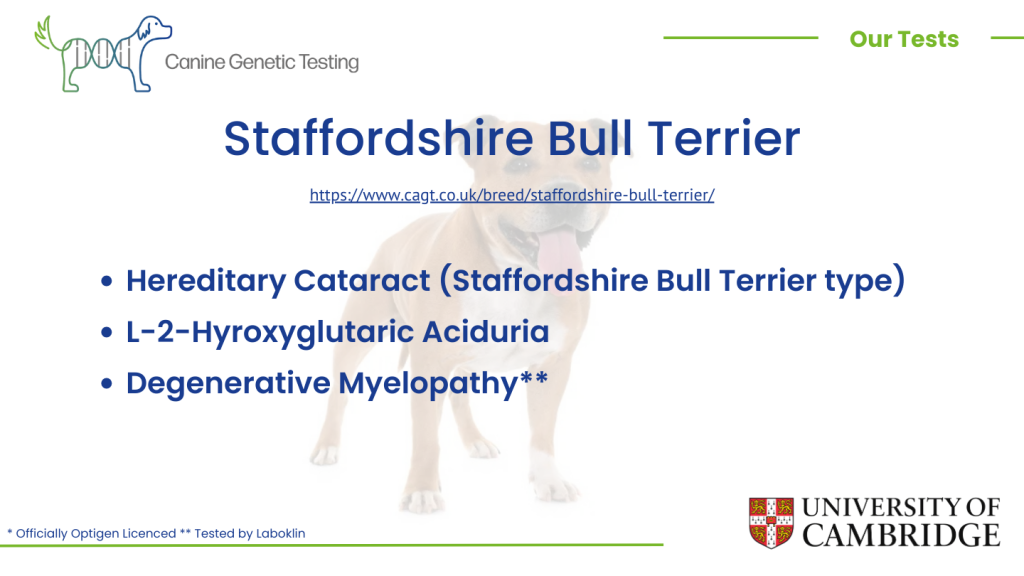 The Canine Genetics Centre has worked closely with many breeds over the years, to investigate inherited disorders that represent a challenge to their health. In the first of a series of ‘Spotlight’ articles we would like to share the story of how we worked with the Staffordshire Bull Terrier community to understand the underlying genetics of two serious and debilitating diseases and develop DNA tests for them both, thus providing the tools with which to eradicate both these conditions from this much-loved breed.
The Canine Genetics Centre has worked closely with many breeds over the years, to investigate inherited disorders that represent a challenge to their health. In the first of a series of ‘Spotlight’ articles we would like to share the story of how we worked with the Staffordshire Bull Terrier community to understand the underlying genetics of two serious and debilitating diseases and develop DNA tests for them both, thus providing the tools with which to eradicate both these conditions from this much-loved breed.
 This story starts as far back as 1978, when the esteemed veterinary ophthalmologist Dr Keith Barnett published a paper describing inherited cataracts in, amongst other breeds, the Staffordshire Bull Terrier. In the Stafford, hereditary cataracts (HC) develop early in life, and if not treated with expensive and invasive surgery, result in total blindness by the time the dog is three years of age.
This story starts as far back as 1978, when the esteemed veterinary ophthalmologist Dr Keith Barnett published a paper describing inherited cataracts in, amongst other breeds, the Staffordshire Bull Terrier. In the Stafford, hereditary cataracts (HC) develop early in life, and if not treated with expensive and invasive surgery, result in total blindness by the time the dog is three years of age.
Anecdotal reports of HC-affected SBTs started to manifest in the late nineties, and then an outstanding dog called CH Jodels Mr Cool, who was best of Breed at Crufts in 1999, was identified as a carrier of HC, which has an autosomal recessive mode of inheritance.
The Staffordshire Breed Council took note and credit must also go to Laureen Williams, owner and breeder of Champion Jodel Mr Cool, who removed him from stud immediately, and joined in with the huge efforts to collect DNA from eye-tested dogs (both affected and unaffected by HC) and to raise funds to support the genetics research, which would be undertaken at the Animal Health Trust (AHT). It was around this time that the Kennel Club appointed Dr Jeff Sampson as KC Co-Ordinator for Health, and Dr Cathryn Mellersh returned to the UK from Seattle, to begin working at the AHT alongside Keith Barnett. So all the pieces were in place for progress to be made – an engaged breed community, the relevant clinical and genetics expertise and funding.
As work began to investigate the genetics of HC, cases of another potentially recessive disease started to come to light – this time a metabolic disease that caused affected dogs to suffer from neurological signs, including seizures. In 2002 a dog called Madge was diagnosed with what was termed L2 hydroxyglutaric aciduria, or L-2-HGA for short, and the journey to investigate this disease began alongside the HC investigations.
This research was taking place during the first few years of this century; the first finished draft of the human genome had only just been released (2004), and the canine genome sequence would not be published until December 2005. So it was with an immense sense of achievement that during 2005 Cathryn Mellersh was able to announce that she and her team, along with clinical collaborators, Keith Barnett, Carly Abramson and Jacques Penderis, had not only identified the mutation for L-2-HGA but they had found the HC mutation as well.
In January 2006 KC official schemes for both HC and L-2-HGA were approved, meaning DNA test results would be sent automatically directly to the Kennel Club and recorded on their registration database, and a programme of seminars were held, to provide breeders with information and advice regarding using the DNA tests to eliminate these disease variants safely, without reducing diversity.
To date, approximately 3,500 Kennel Club registered Staffordshire Bull Terriers have been screened for both the HC and the L2-HGA mutations, and around 50,000 dogs are known to be hereditarily clear. And these figures just pertain to UK dogs – presumably the number of dogs tested worldwide is much higher.

This is very much a condensed outline of what amounted to an enormous effort by the Staffordshire breed community. The honesty of the people who owned and bred the early affected dogs was absolutely integral to this success story, alongside the tireless efforts of key individuals including Ivor Keyes, Lesley MacFadyen and the group of like-minded breeders that they led, who collected DNA samples and raised funds. Without their combined efforts, this work would not have been possible at a time when the genetics resources with which to investigate canine inherited diseases were very much in their infancy.
The fact that two novel inherited diseases came to light at more or less the same time, in the same breed, was simply unlucky. The mutations are in different genes and occurred independently from one another. Mutations happen at random. Not all mutations cause inherited diseases – but when they do, because of the structure of breed dog populations, they can spread quickly, particularly when they occur in popular dogs.
The Canine Genetics Centre (CGC) exists to investigate inherited diseases in dogs. No breed wants to have to call upon the services of the CGC – but if the need arises, the CGC will work with the breed community to collect appropriate DNA samples, secure funds and undertake the necessary research to gain a better understanding of the underlying genetics of the disease. And when the research is complete, they will develop suitable DNA tools with which to reduce the prevalence while protecting genetic diversity.

“I started investigating HC in the Staffordshire Bull Terrier almost as soon as returned to the UK, in 2001, and to lead the research that led to the identification of the mutations for both HC and L2-HGA has been one of the highlights of my career. But I could not have achieved so much, so quickly, without my clinical collaborators, and the dedication and engagement of this wonderful breed community. Many things are required for successful research; DNA samples, clinical expertise, stakeholder engagement and funds – luckily, we had all of these in place and the dogs have reaped the rewards as a result.“
Canine Genetic Testing offers a discount on their Staffordshire Bull Terrier bundle, and until the end of December is offering a 20% discount on individual HC and L2-HGA tests as well.


